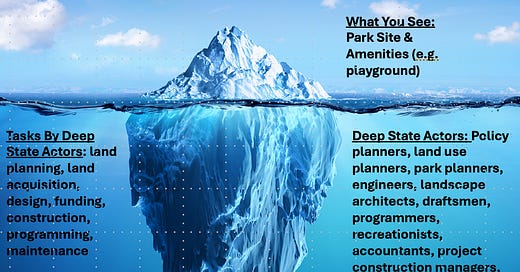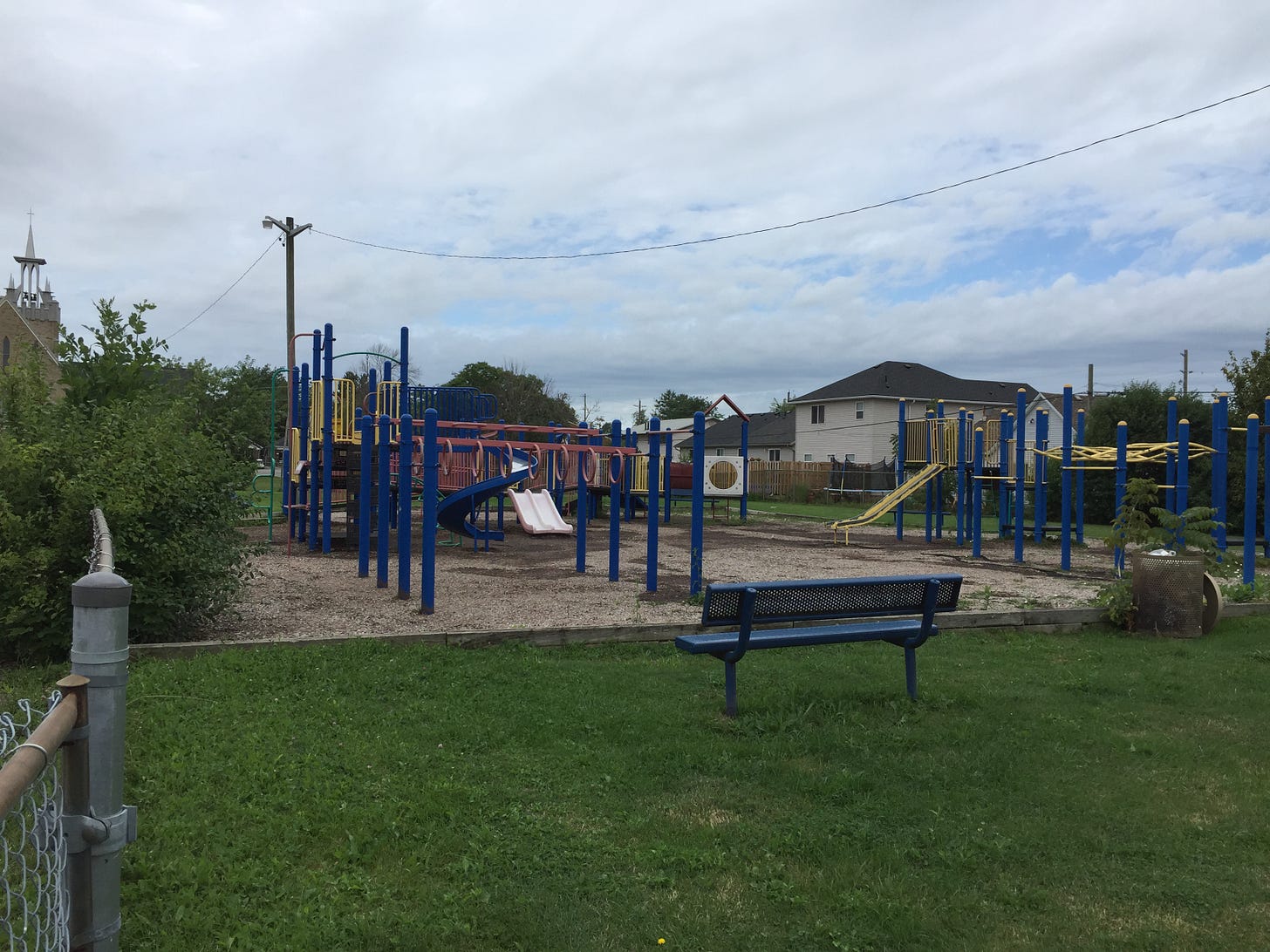Parks Civics: The Parks Deep State (March 26, 2025)
...The Case of the (Missing) Playground Inspector
Vlog Overview
"Parks and Like Icebergs" is an exploration of various aspects related to municipal parks, including urban parks planning and subsequent park service operationalization. Aspects discussed include policy, strategic planning, park system planning in area plans, park land acquisition through purchase or subdivision, zoning, plans of subdivision, engineering drawings, servicing agreements, and construction approval processes. What you see on the ground is based on a multi-phased multi-year with multiple social actors based on legislation, policy and practices that are largely unseen nor understood.
The vlog marries my extensive municipal planning experience (32+ yrs), including 29+ years as a parks practitioner years, with a PhD in parks planning decision-making using institutional theory in Edmonton Albertan in park land decision-making. In addition, I have created and taught four, three credit courses, in municipal parks planning at the University of Alberta in their urban planning program to fourth year and graduate urban planning students. The University urban planning program has been accredited by the Canadian Institute of Planners. See my “about” section that describes in more detail my lens (including biases) shaped by my education, background and experiences. I am available as a teacher, guest speaker, coach, consultant, keynote speaker, etc.
The vlog's intended audience include elected officials, planning professionals, landscape architects, consultants, community engagement practitioners, recreationists, academics, community NGOs, and individual and group planning process social actors. I also have a Phd, in sarcasm, use self deprecating humour, storytelling, with lots of adjectives and adverbs. Parkies (like me) gotta’ have fun.
Recently news reports and social media in the United States have been animated with discussions of the indiscriminate disparagement and gutting of the public service to eliminate fraud or abuse. Disparagement of public servants is most often pursued by those seeking to reduce and/or minimize government roles and responsibilities. The role of government, its size and scale vis a vis the private sector is a legitimate public debate to have. Any and all government tax dollars should be spent efficiently and effectively. However, the power and agency for many public servants is limited depending on where they are in the organization and their role. Their voices may be heard, but can also be muted or silenced by senior administrators or elected officials. This is their story (du da).
Ice Sculpture: Parks Civics - The Parks Deep State
Lets talk about park public servants, and specifically park employees. Who are these people? What do park employees actually do? Why do they act, or choose not to act? How are they qualified or trained to do their jobs? What is their bottom line?
Who Are Park Employees ?
They are your neighbours, you daughter or son, uncle, dad, mom, or you goofy second cousin on your fathers side of the family. They could be young or old, straight, gay or bi, are married or single, with or without kids, worship a god or not, are black, white or another colour or race, rich or poor on in the middle, a gun owner or not, live on a farm, a small town or in a dense city. They may be an immigrant new to your country, or their family has been here for generations. Yet, they are everyone you see around you in some way.
What Do Park Employees Do?
Governments are divided up into multiple entities, specific to the type and level of government, and the services they deliver. Urban planning legislation and park reserve dedication amounts is the purview of provincial government. Municipal governments work with landowners and developers to allocated park land across an urban landscape and provide park services.
Municipal elected officials are typically responsible for setting strategies, policies and priorities, including capital and operating budgets. Park public servants are hired to fulfill a specific role in planning, acquiring, designing, constructing parks are providing park services. Processes and process management (i.e., practices) are the place where park employees do their magic to implement higher order legislation, strategies, policies and priorities. In otherwords, they apply the macro higher level directives in a micro (i.e., site) setting.
There is a huge diversity of tasks and activities, from plan reviews, grass cutting, engageing with the public, running festivals, trimming trees, budgeting, etc. The example I will use below is someone who inspects manufactured play equipment. Park employees create indoor and outdoor public parks and recreation activities on sites materially allocated across an urban landscape providing a diversity of recreational, leisure, education and ecological benefits.
Why Do Park Employees Choose to Act, Or Not Act?
We live in a messy world where needs outpace resources. Black and white application of macro high level directives (policy/strategy) to the micro (i.e., a park site ) is sometimes complex because they compete with each other for resources. Employee roles inevitably have a level of discretion, but only within the four corners of approved legislation, strategies, policies, processes, practices, and priorities. In other words, their acts are driven by directives given to them, and further defined in individual job descriptions.
In the parks world, application of macro or micro policies is further complicated by the integral role of non-state community social actors who are integral to park service provision (i.e., volunteers). A member of the general public may not be able to see or decipher highly technical professional standards/rationales, the higher level documents or legislation that drives action, or the relationships developed to deliver park services, that drive decision-making.
What is the Park Employee Bottom Line?
Big picture, park employees provide a service to the public. Public servants serve all citizens, not a select group of shareholders. Governments often operate in areas that profit motives are either unethical or impractical, nor would should they be monitized.
There are no financial bottom lines per se that drive public service. Public servants are generally not there to generate profit, but must act efficiently and effectively in their role to maximize community benefit writ large, quite often in ways that are not immediately defined by dollars and cents (i.e., ecological goods and services, health and wellness), or are enjoyed by other levels of government (i.e. healthcare). Some roles do involve revenue generation (i.e. recreation centres), and others facilitate community fund raising to reduce costs to municipal taxpayers for park amenities or provide services (i.e., through volunteerism). As a long time parkie, I always believed that the process of decision-making is equally as important as the outcome.
What Is The Background of Park Employees?
Implementation requires a broad range of knowledge, skills and expertise. Some of those roles require certified knowledge and skill sets, often acquired at university, college or trade school before and during employment. Still others may or may not have a high school diplomas. Each role/job has specific tasks, defined in job descriptions. Those in more senior levels (i.e., management) tend to have higher levels of degrees/certifications and years of experience.
A few examples of such background for parks include planning education for urban planners, urban forester education/accreditation, training/accreditation to apply pesticides and herbicides, playground equipment inspection, fitness training, heavy equipment operator licences or mechanics, accounting, ecology, civil engineering, etc.
A Park Site Deep Dive
I will use a single type of park and park amenity (i.e. a playground) as as exemplar of how state actors are engaged in site development and service provision. I will go into the weeds a bit, to elucidate roles and activities that are shown in the graphic at the top of this vlog.
Park policy planners create park master plans that identify playgrounds within a park typology. That typology is also linked and supports other implementation documents (i.e., the Joint Use Agreement, Tri-Partite Lease Agreements, City Construction Standards, Zoning Bylaws). Park planners review area plan proposals circulated by land use planners that identify park systems, based on the park master plan typology that effectively indicate what sites will have a playground. Park planners with land use planners track and assemble municipal reserves (cash, land or combination thereof) in subdivision processes on every single parcel subdivided across an area plan and neighbourhood, regardless of the presence of public park lands, in order to assemble the school and park site itself. Multiple engineering drawings and servicing agreements are reviewed by park planners to ensure utility and roadway servicing is provided to the park site itself. Park planners rely on servicing advice from internal by city civil engineers, who review review both transportation impact assessments, servicing design briefs. Park planners also rely on ecologists to identify natural areas for retention, that will materially impact the land mass available for manicured parks where a playground would reside.
One the site is assembled and serviced (i.e. roads, power, internet, storm water and sanitary sewers) cost estimates are required for base and shared level park amenities for inclusion in a capital budget for review and approval by elected officials. Cost estimates require the development of a site development master plan, detailed construction drawings developed by landscape architects and draftsmen, and construction project managers). Internal operational staff (i.e., grass cutters, horticulture staff, urban foresters) review the plans at this point in time for inclusion in future operating budget cycles, including playground structures. Construction Plans including play equipment must be consistent with the city construction standards manual. This document itself is reviewed and approved by City Council and applies to all development on city owned land.
Once the funding and zoning has been secured, the entire park site can now be constructed to base level (i.e., graded, levelled, seeded, trees, signs, sport fixtures, site underground utility servicing) and shared levels. This work be done by internal crews, tendered out to private sector landscape construction firms or a combination thereof. Park planners also initiate zoning bylaw amendments with land use planners to align the proposed development. This requires a public hearing, and approval by elected officials. Prior to this, a public meetings are held by recreation outreach staff to inform the community of the upcoming zoning, construction program and schedule.
The construction process is monitored by city and contractor landscape architects and/or landscape technicians to ensure compliance with the construction standards manual. Construction involves heavy equipment, equipment operators, etc. A two step construction review process occurs. Once construction is completed consistent with the construction drawing plan, the park site is reviewed for compliance by city forces (i.e., landscape architects, construction, landscape techs, horticulture, etc). If successful, a construction completion certificate can be issued. One or two years later the site has had time to mature enough to understand if the constructed assets aresustainable in the long term for maintenance takeover by the municipal government (i.e., facility acceptance certificate).
Playground construction may occur when the site initially constructed, when a school is constructed by the Province of Alberta, later by the community on a cost shared basis or sometimes when a develop volunteers to fund portions of a park site. Community cost sharing processes may be a 2-3 years period of development and site plan reviews working recreation outreach staff, planners and landscape architects), at reduced costs to the municipality. Playground equipment installation may also be partially provided by community volunteers: we used to call that “sweat equity.”
The first two options may not engage the community in playground equipment selection, but will be available earlier in the lifecycle of a neighbourhood. Regardless of timing and construction responsibilities, the equipment selected must meet Federal Government safety standards. Playground equipment is provided by a private playground equipment contractor, paid for by whomever is funding the playground. Today in Edmonton park sites use universal design standards which may mean playgrounds or a portion of the site are accessible to those with physical, mental or auditory disabilities. Playground plans are reviewed and approved in processes including landscape architects, draftsmen, recreationists, and operations staff, as well as the community.
Finally, when all the construction processes are completed, the playground can be opened and is accessible to the community. City operational staff take over maintenance of the amenity, including periodic site visits (i.e., on a cycle basis, which may be once every 11 days) to ensure equipment remains safe for users. Below is a graphic and description of how a playground was built in the Blue Quill neighbourhood below.
The Joint Use agreement co-located school and parks on the same site was approved in 1960, the 1970-1980 City of Edmonton Parks Master Plan was the source of the park typology for this area plan. Kaskitayo Outline Plan (area plan) was approved in 1971, that included the Blue Quill Neighbourhood. Prior to approval, this land was a farmers field. The park and park services are cost shared with community in relationships that exist today.
Each type of site or amenity has a similar story. In summary, expertise required to plan, design, construct, and maintain a park including a playground include park and land use planners, civil engineers, landscape architects, draftsmen, landscape technicians, construction project managers, construction crews, operational staff, urban foresters, elected officials, recreation outreach workers, materials management/accountants, playground equipment manufacturers, etc. Community and community fund raisers, are part of the park institution described earlier in this vlog, are not part of the administration, but both rely upon and depend on the above the expertise noted above to facilitate the development of a park site, and within that, a playground.
A Playground Inspector Deep Dive…
By way of example, lets talk about what may be the role of a single type of municipal actor in this process in a specific neighbourhood: a playground inspector who is employed in an operations (i.e., maintenance) department in a municipal government. The area plan in Blue Quill was created in 1971 by land use and park (systems) planners based on the directives of the 1970-1980 City of Edmonton Parks Master Plan, and the Joint Use Agreement. The park site was acquired, assembled through subdivision and purchase, and serviced (i.e., roads, power, storm and sanitary sewers) by the early 80s. The Nieghborhood Park Development Program was also created in the early 80s as well to cost-share new playgrounds and other park amenities. Elected officials downloaded 50% of the cost of park amenities to the community. At this point, a farmers field has been transformed into multiple assembled parcels, roughly graded and seeded, but absent any park amenities. No playground was present, but the parks master plan would have identified a site for such amenities as planned for this site, typically in close proximity to schools.
A playground inspector would have had input into the high level construction standards manual with respect to playgrounds, and the specific construction drawings/plan approved for the playground implementation for the Blue Quill site. The inspector be trained in safety standards for such equipment, and would have identified the maintenance cost in future operating budget processes in the year prior to the completion of the structure. When the FAC is requested, the playground inspector is part of a broader team of municipal actors who determine if the playground construction was built as per the construction drawings/plan.
Once the FAC was accepted by him and other internal staff, the inspector visits the site periodically (e.g., every 11 days) to ensure the equipment remains safe for public use. Minor repairs may be undertaken. Municipal forces keep track of infrastructure maintenance status on an on-going basis. At some point in time, likely 10-15 years, if the equipment is no longer repairable, it is removed for public safety reasons. The inspector would inform the recreation outreach workers about the declining health of the structure. Recreationists would reach out to the community about beginning a renewal process to replace the equipment. Meanwhile, the inspectors are off reviewing new construction drawings on other sites and inspecting and repairing playground equipment on multiple sites.
My Inspector/Service Take…
Playground inspectors are necessary to ensure playground equipment of each and every playground is safe for public use during plan review stage and after they are built. In addition to actual equipment inspections where they apply their specific training, they feed both capital and operational budgets and practices. Haphazard removal of this expertise would mean new playgrounds could not be constructed, identified in future budgets for repair, nor would repairs occur. Access to playgrounds may also be limited if staffing levels are stretched (i.e., diminished) such that they cannot keep up with the demand. A loss or diminution of this expertise means planned park amenities in area plans and the parks master plans, both approved by elected officials, could not be implemented, delayed and/or could be unsafe if provided. The latter would mean the city would be legally libel if someone was injured, or worse. Park spaces considered unsafe by the community will not be used. The benefits of childrens play and learning on playgrounds would be reduced if playgrounds are not provided or are not safe.
This is but one example of a type of park expertise embedded within an organization that toils is relative obscurity for the public benefit. You may not know who they are or what they do, unless your second cousin on your fathers side of the family is employed in such a role for the past 10 years. She has a baby on the way, and you attended her baby shower recently. She tells you some wingnut politician is trying to fire her for no apparent reason, claiming she sucks at her job, despite positive performance reviews. These are not people to fear, nor traumatize just because they inspect your local playground and are employed by the local municipality. They make your community safe.








